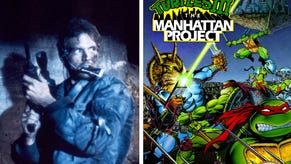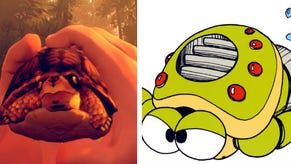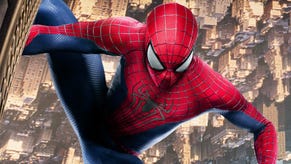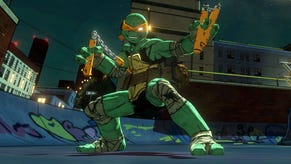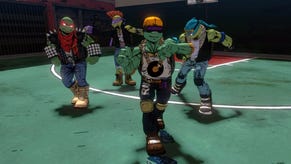Turtlevania: On the Non-Linear Design of TMNT: Danger of the Ooze
A chat with the director of WayForward's upcoming Ninja Turtle platformer regarding the dark science of capturing metroidvania magic.
This article first appeared on USgamer, a partner publication of VG247. Some content, such as this article, has been migrated to VG247 for posterity after USgamer's closure - but it has not been edited or further vetted by the VG247 team.
I didn't give a second thought to Activision's upcoming Teenage Mutant Ninja Turtles: Danger of the Ooze when I first heard about it. Why would I? I'm a grown man, and much too old to be excited about some licensed game based on a cartoon.
Then I learned that Danger of the Ooze is a non-linear platformer by WayForward Technologies, and in fact was the same title that director Tomm Hulett had been obliquely teasing to me on social media over the past year. Hulett knows about my weakness for metroidvania games, because he shares it. I've spent a lot of time over the past couple of years trying to figure out what makes that particular subgenre tick — trying to determine the difference between a good attempt, like Strider, and a great one, like like Guacamelee! Licensed platformers based on kids' cartoons typically aren't a breeding ground for great game design, but knowing that Danger of the Ooze is being directed with someone with a critical eye for the genre got me curious to learn more.
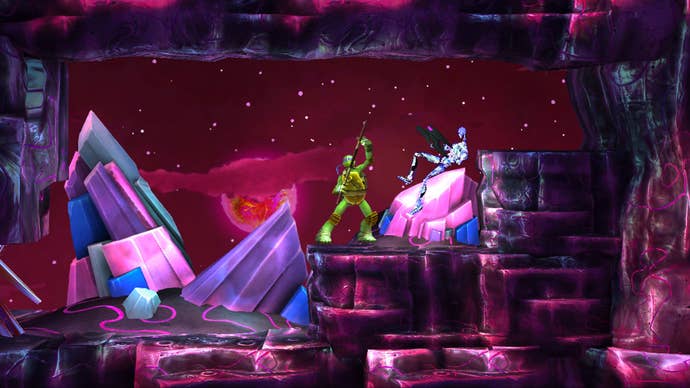
USgamer: The Ninja Turtles have seen a lot of incarnations through the years, from the cartoons of the '80s to the recent Michael Bay flick. What franchise influences are you drawing on, beyond the Nick cartoon, with Danger of the Ooze?
Tomm Hulett, Director, WayForward: The current Nickelodeon incarnation factors in a lot of the franchise history all by itself, which is great. By just staying true to the current show, we have enough to draw in fans of the classic 'toon, the original comic, and everything in between. But since everyone on the team is a fan of TMNT, our own personal experiences find their way in whether we like it or not. We did try to keep references subtle so they didn't overshadow the current stuff, which honestly has become the "preferred TMNT" for many of us.
USg: How about TMNT games? Are you looking to previous games in the franchise for inspiration, or do you find it better to start fresh?
TH: We're not directly borrowing from old games, but again we're WayForward, and we've never been shy about our roots in classic gaming. Nintendomania and Turtlemania were concurrent phenomena, and it's hard to separate the two, so there are definitely background nods. Jake Kaufman's amazing score will send shivers up the spines of classic TMNT gamers.
The biggest lesson the classic arcade game taught us is when working in a licensed universe, let the game wallow in it. Paint every aspect of the game with TMNT paint and be shameless about it. We all loved that game for its huge, animated sprites and its colorful recreation of the cartoon's settings. This is useful for any licensed title, not just TMNT, but we definitely took the philosophy to heart.
As far as actual gameplay elements, we tried to start fresh. When it came to balancing the four turtles, I actually looked to do the opposite of the original NES game. My favorite turtle happens to be Raphael, who not only had the shortest range back then, but also the lowest attack value. It made no sense, but more importantly, it made it impossible to use my favorite turtle. Instead I was stuck using Donatello, and if he died early I'd just restart. I didn't want kids of today to relive that frustration. So we tried to balance every turtle as a viable choice. They're maybe not the BEST choice for a situation—but they're never the wrong choice.
USg: I've seen Danger pegged as being in the metroidvania style. This isn't the first non-linear Turtles game — Radical Rescue for Game Boy did that, too — but it's pretty uncommon for the franchise. Most games go with a linear brawler style influenced by the Konami arcade games. So why break tradition?
TH: From day one, Activision wanted to take this game in a different direction than brawler, which as you pointed out has been done many times already. It was actually their suggestion to try an exploration-based action platformer, which I was ecstatic about. For years now I've been imagining an urban take on the genre with multiple player characters, and it was a dream come true to realize that with TMNT.
I actually hadn't checked out Radical Rescue until last week, and there are definitely a couple similarities. So there you go! References we didn't even know we were making!
USg: One of the key design philosophies in the Metroidvania subgenre is that your characters gain the ability to explore new areas as they gain new powers. Meanwhile, TMNT has four unique characters with different specialities. So... how do those two elements fit together?
TH: As you can tell from my anecdote earlier, this was something we put a lot of thought into because it was a crucial balance to get right. Ultimately we settled on a fairly simple solution – upgrades you find that increase your capabilities are global. If Donatello learns a special move, Michelangelo gets a corresponding special move. If one turtle can dash, they can all dash.
Where the turtles differ are their basic combat abilities. Each character has his own rhythm, so they each feel a bit different. Raph is normally short ranged, but his midair attack is a jump kick, while Leo's standing and jumping attacks are relatively uniform in range. So zoning, speed, and combo length all factor in. Additionally each turtle has a little extra ability—Leo gets bonus damage on counter attacks, for example—these aren't major things, but they could matter in a pinch – every character controls the same and has the same number of moves, but they definitely feel unique and will appeal to different players.
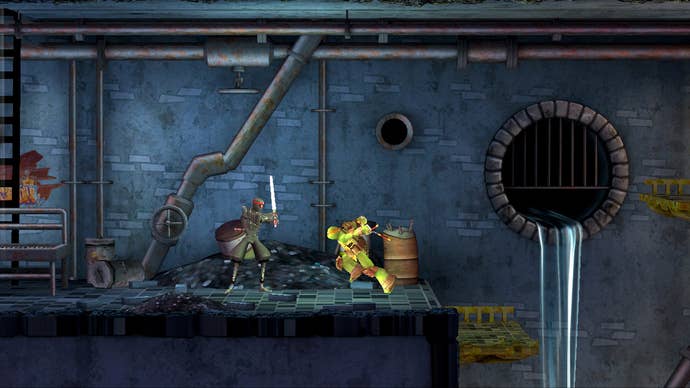
USg: There have been lots of good metroidvania games, but very few truly great ones. How do you plan to cross over that difficult threshold?
TH: Step one, I'm an exploration-based action platformer snob. The genre's had an embarrassment of riches lately, but I find that most of those games trend firmly toward the latter end of the portmanteau. There are a lot of subtle differences between the two and while I love them both, I don't feel the former half has gotten the love and attention it deserves. Many feel it's just "add some isolation" but it definitely runs deeper than that, and I wanted to prove it.
Step two, make the team as fanatical as I am about the difference. I tracked down every game analysis of notable genre classics the internet had to offer, and we played the games (many games) together as a team. Fortunately everyone was a good sport about it and took the homework seriously.
Step three, I personally mapped the game's progression from upgrade to upgrade, planning out their locations from the macro level on down to specifically which room they'd appear in. I spent a lot of my Christmas vacation last year hunched over my living room table, charting it all out in far more diagrams than is strictly necessary.
Finally, of course, we tested the heck out of it, adjusting upgrade locations and pacing until we were completely satisfied.
USg: Are you looking to more contemporary games like Guacamelee (which did a great job of combining exploration and brawling) for design tips as well?
TH: We played them all. Not so much for design tips, but more to get an idea for the current zeitgeist, or at least avoid accidentally sharing a mechanic with a game we didn't happen to play. It always happens (see: Radical Rescue, above), but I like to avoid it where possible.
One thing I noticed in a lot of modern action platformers, including some of WayForward's own, is locking the player into combat encounters like a brawler would. In these cases, the player is happily moving through an area, then suddenly BAM – enemies appear, the camera locks, and they've got to fight their way out. Sometimes there are invisible barriers, other times the doors get electrified or something, but the effect is the same: you fight or you never leave.
In the right context, this can be a nice mini-boss style situation and provide some good tension. But lately it's become the combat standard for many exploration-based action platformers, so we decided to avoid it. It's a shame to give the player a suite of cool navigation abilities and then force them into combat in this room on this platform… just because the game said so. In TMNT we have a lot of cool moments where, maybe the first time you walked down this street, you had to fight a bunch of guys because there was no other way past them… then two hours later you return with an air dash and smoke bombs, and you can deftly avoid them, sneaking through without ever being spotted. That's exciting! I think it's a much bigger rush than simply repeating a combat encounter. The idea is, since the player is becoming a better ninja, we'll let him act like a better ninja.
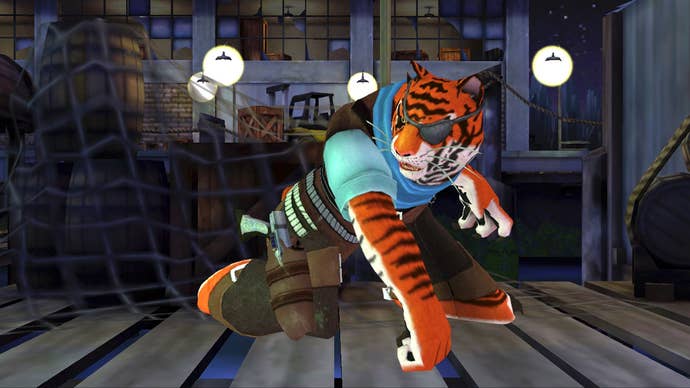
USg: Beyond the question of influences, what new ideas and innovations are you hoping to bring to the Turtles? In other words, how do you hope to make your mark on this venerable franchise?
TH: We poured a lot of passion into Danger of the Ooze, with everyone contributing ideas and going the extra mile to make it something special. I'd like that to come across to the young fans playing it—hopefully making this as iconic an experience for fans as the classic TMNT games were to us.
At the same time, we realize that despite the countless exploration-based action platformers on the market today, TMNT might be somebody's first. So we really tried to make it a great example of the genre—it's speedrunnable, sequence breakable, and anything else you'd expect to find. On the console versions, our Achievements are designed to encourage that type of experimentation on replays. I think the genre was a perfect fit for the franchise—maybe in 25 years an interviewer will ask why they decided to try a brawler, after years of successful exploration-based action platformers.
Beyond those lofty goals… I wrote some funny cut scene dialogue. Maybe someone will laugh at the jokes. I'd be happy with that.

